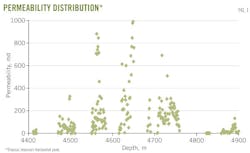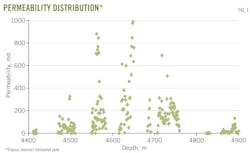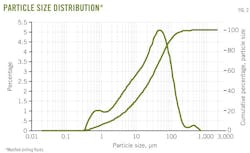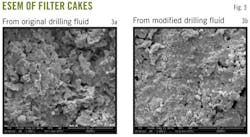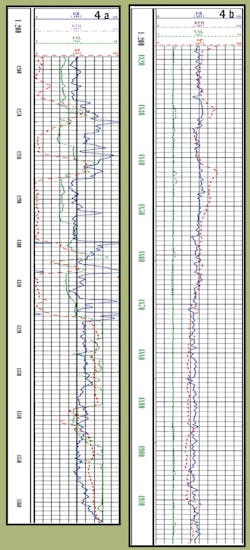Optimized fluids improve production in Tarim horizontal wells
Lijun You Yili Kang
Southwest Petroleum University
Chengdu
Zhangxin Chen
University of Calgary
Calgary
Xiao Niu Faqiang Luo
Sinopec Northwest Co.
Urumqi
China
| Based on a presentation to the SPE European Formation Damage Conference and Exhibition, June 5-7, 2013, Noordwijk, the Netherlands. |
Well productivity is reduced by formation damage caused by drilling fluids, especially in horizontal wells.
The mechanisms, consequences, and remediation technologies of formation damage have been studied in depth over the years. However, the damage to Triassic, high-permeable reservoirs—in which horizontal drilling is used to great effect—has received little attention. Generally, this is because highly permeable reservoirs can continue to produce oil and gas even when damaged, although at a less-than-optimal flow rate.
The fact remains that horizontal wells are more susceptible to formation damage. The invasion depth of damaging mud filtrate and solids into the near-wellbore region of horizontal wells is often greater than in conventional, vertical wells.
This disparity derives from a horizontal well's flow mechanics, long drilling and completion time, and filter-cake erosion caused by a poorly centralized drill string or multiple-tripping operations.1
In horizontal wells, high overbalanced pressure and longer exposure to drilling fluids can result in extensive formation damage, as well.2 Permeability heterogeneity, permeability anisotropy in the top, side, and bottom, and filter-cake-rock-tool interaction caused by the eccentric rotation of a drilling string cause more damage in horizontal wells than vertical.3
This article looks at a Triassic high-permeable oil reservoir in the Tarim basin of northwest China to analyze horizontal drilling results. From this analysis, we describe how optimized drill-in fluids can control reservoir damage, regain high permeability, improve wellbore quality, and increase production after completion of horizontal wells.
Disappointing early results
The Tarim basin contains well-developed, channel-sand reservoirs, characterized by medium porosity, medium-high permeability, rich clay minerals, high formation salinity, and strong heterogeneity.
The size of its large pores can reach up to 400 µm and the throat radii can reach up to 69.4 µm. The porosity is 22-28%, and the permeability averages 2.0~2,048 md and averages 599 md.
The types of clay minerals are mainly kaolinite, chlorite, and mixed layers of illite and smectite. Formation water salinity can reach more than 200 g/l.
Over the past 2 years, China has turned to horizontal drilling in the Tarim reservoirs to increase oil recovery. However, formation damage has taken its toll.
After completion, most Tarim horizontal wells produced around 20 tonnes/day (tpd) via natural energy or gas lifting. That rate is on par with a conventional, vertical well, which is disappointing.
The lengths of Tarim horizontal wells are about 400 m. Reservoir heterogeneity is strong, and the permeability along the well ranges from 0.1 md to about 1,000 md (Fig. 1).
However, a decrease in the well's pressure coefficients from1.08 to 0.7 occurred after 2 years' development. The formation damage caused by high overbalanced pressure lowered the production rate of Tarim horizontal wells.
It became clear that any invasion of solids or liquids must be controlled because it is difficult to flow back and remove these materials when invasion occurs in the deep radius around the borehole.
Diagnosing the problem
Cationic-emulsion-polymer, water-based drilling fluids supplemented with noninvasive agents are widely used in horizontal well drilling in Triassic reservoirs. In Tarim reservoirs, fine CaCO3 was used as a bridging agent and selected based on the one-third or two-thirds bridge principle4-5 or the ideal-packing theory, which also says that the bridging agent size should be one third or two thirds of the pore-throat size.6
Non-invasive agents are popular among drilling and completion fluid engineers because of their sealing pore throats and micro fractures. One properly formulated, ultralow invasion fluid should reduce formation damage and optimize well productivity.7
However, if noninvasive agents actually do invade too deeply, they are difficult to remove from the pore throats. In this scenario, the regained permeability of the well drops to less than 40%, due to the adsorption of noninvasive agents.8
With a pressure coefficient of 0.7 in some Tarim reservoirs, underbalanced drilling causes operational problems and overbalanced drilling and completion must be employed. If solid particles do not match the size of a pore throat, they will invade too deeply into the reservoir and will not flow back easily, increasing the potential for serious reservoir damage.
To study this, we took return-permeability measurements of the original drilling fluids on Tarim reservoir core plugs by cycling the drilling fluids under a 3.5 MPa positive-pressure difference at 90º C. for 1 hr.
We found that the drilling fluids reduced filtration to less than 3 ml. cumulative volume of all cores under these conditions. The portion of the return permeability of core plugs with less than 100 md was more than 80%, while that of core plugs with more than 400 md was less than 50% for the most part (Table 1).
The low cumulative volume and return permeability mean that solid-particle plugging may be the main cause of damage, and merely reducing filtration is not enough to control formation damage.
Based on laser-particle-size analysis, the distribution of drilling fluid particle sizes was D50=7.258 μm, to D90=36.549 μm. The D50 of the main bridging agent, CaCO3, was 14.3 μm, and D90=34.47μm.
That is, the D90 of the suspended solids in the original drilling fluids was just a third or less than a third of the large throat diameter in the Tarim reservoirs. The filter cake could not be formed quickly enough, and the solids and liquids of the drilling fluids invaded too deeply into the large pore throats.
This caused irreversible permeability reduction. Therefore, the optimization of particle size distribution became imperative.
Controlling the damage
Controlling the filter-cake properties of drilling fluids is vital, as well. The fluids need to form a plugging zone with ultralow to zero permeability near the borehole wall to prevent drilling fluid solids and liquids from invading too deeply, and they must do it quickly. This is particularly true when the drilling fluids contain long-chain polymers such as noninvasive agents.9
Much of a reservoir's production flow comes from the largest pore throats. These higher permeability-porosity zones should not be ignored, either.10
We took several measures to modify the original drilling fluids. First, we added fibrous bridging agents to the original drilling fluids. These agents are typically used in a fractured reservoir. Instead, we used them to seal the large pore throats as quickly as possible. Bridging agents can more rapidly and stably seal pore throats than granular bridging agents.11
More than 95% of our bridging agent was CaCO3. The size distribution of the fibrous bridging was D10=23.01 μm, D50=24.37 μm, and D90=92.12 μm (Fig. 2).
Next, we enlarged the bridging-agent size to 0.8 times that of the large pore throats. We relied on Abrams's Rule for the selection of bridging particles, although the Shielding Temporary Bridging approach may be effective in homogeneous formations, as well.5
Because of the high porosity and large pore throats of the reservoir, two or more bridging particles may be required to seal one pore throat if the bridging particles are too fine. This results in deep solid and liquid invasion and a large amount of bridging-agent consumption.
In addition, enlarging the size of the bridging agent also can increase mud density. To combat this, we selected a 150~200 mesh (74~110 μm) CaCO3 as the weighting and bridging agent. We decided against using nonacid-soluble barite because its particle size was mismatched with the pore throat.9
High quality, multifunctional agents can make it easier to adjust drilling mud viscosity and improve the flow-back ability of filter cake through spontaneous or acid-aid removal. It is important to limit mud solids and filtrate invasion and to obtain acid-degradable mud cakes that require low-differential pressures.
We optimized the agent concentration based on reservoir geology and the return-permeability of the drilling fluids. The concentration of our lubricant, emulsion paraffin, was decreased from 3-4% to 2%. The type and concentration of noninvasive agents were optimized according to our dynamic circulation experiment results.
Finally, we incorporated the bridging agents during drilling operations. The concentration of the agents quickly decreased because of the high porosity and large pores of the reservoir, the continual stripping action of larger solids, and the interaction of large solids and tools during the cycling of fluids. We found that maintaining the concentration and distribution of the bridging agents is as important as selecting the proper agent, itself.
We then took return-permeability measurements of the modified drilling fluids by cycling them under 3.5 MPa pressure difference at 90° C. for 1 hr. The results show that the return-permeability percentage of all core plugs was more than 80% (Table 2).
We took cross-sections of the core plugs obtained by cycling the original and modified drilling fluids and compared them, using an environment scanning electron microscope (ESEM). The two samples (Nos. 5 and 7) were outer filter cakes of the two core plugs.
The ESEM images indicated that the No. 7 filter cake, formed by the modified drilling fluids, had smaller porosity and pore size than No. 5, which was formed by original drilling fluids (Fig. 3).
The porosity and average pore size of the No. 5 filter cake measured by image analyses were 7.6% and 0.472 μm. Those of No. 7 were 4.8% and 0.383 μm. This demonstrates that the optimized drill-in fluids formed higher quality filter cakes.
Modified drilling fluids
We expanded our research in the field by partnering with China Petrochemical Corp. (Sinopec). Three experimental horizontal wells were drilled in the Tarim basin with the modified drill-in fluids. Before drilling into the horizontal intervals, we added optimized fibrous agents to the mud.
The rheological behavior of the modified drilling fluids was consistent with the original fluid, and their density in the test wells was about 1.10 g/cu cm. When drilling the horizontal interval, we measured the solid distribution and density of the drilling fluids at regular intervals. Bridging agents and some dilute gel were supplemented during drilling operations.
The three wells were successfully drilled and completed and were all in high-flowing production through natural energy. The flowing production of one of those wells, T9FF, is about 100 tpd. That is five times higher than the 20-tpd production of the two adjacent horizontal wells (T9FE and T9FS) completed the previous year. This production is particularly impressive because the permeability of T9FF is lower than the adjacent wells.
A second experimental well (T1FS) was in open flow on the first day after completion and produced a total production of 53.2 tpd through a 2.0-mm nozzle for 8.5 hr. Again, this was higher than adjacent wells.
When comparing well-log curves of the experimental wells to those of their adjacent counterparts, we saw that their caliper curves were all straight lines and the borehole walls were all very regular (Fig. 4). Borehole collapse and enlargement were pervasive in most horizontal wells drilled with the original drill-in fluids, and pipe-stick incidents were common.
We believe that the superior wellbore quality of the experimental horizontal wells was the result of three factors:
• The optimized bridging agents added into the drilling fluids quickly and effectively plugged the pores of the caving formation to form superior filter cake.
• The tight filter cake on the wellbore wall prevented the borehole pressure from transferring into the formation pores and stopped the invasion of liquids and solids.
• The high quality filter cake mitigated water and alkaline-sensitivity damage caused by filtration-rock interaction.
Simply reducing drilling fluid filtration is not enough. Rapidly sealing pore throats with fiber bridging agents that match the size of the reservoir's pores will control damage and borehole instability in highly porous and highly permeable reservoirs.
Optimizing drilling fluids by adding fibrous bridging agents into the original drilling fluids is effective. Formation damage control practices help stabilize the wellbore and mitigate downhole incidents. Developing new, multifunctional agents that contribute to this should be further explored.
Acknowledgements
The authors acknowledge the support of the National Basic Research Program of China, the China Scholarship Council Fund, and The National Municipal Science and Technology Project.
References
1. Bennion, D., Thomas, F., et al., "Formation damage and horizontal wells: A productivity killer?" SPE 37183, International Conference on Horizontal Well Technology, Calgary, Canada, 1996.
2. Wu, Z., Vaidya, R., et al., "Simulation of dynamic filtrate loss during the drilling of a horizontal well with high-permeability contrasts and its impact on well performance." SPE Reservoir Evaluation & Engineering, Vol. 12 (6), 2009, pp. 886-897.
3. Beatty, T., Hebner, B., et al., "Minimizing formation damage in horizontal wells: Laboratory and field case studies." Journal of Canadian Petroleum Technology, Vol. 34 (6), 1995, pp. 57-63
4. Abrams, A., "Mud design to minimize rock impairment due to particle invasion," Journal of Petroleum Technology, May 1997, p. 586.
5. Luo, X., and Luo, P., "The application study of shielding temporary bridging technology in formation damage control," Drilling and Completion Fluids, Vol. 2 (1992), pp. 19-27.
6. Yan, J., and Feng, W., "Design of drill-in fluids by optimizing selection of bridging particles," SPE 104131, 2006 SPE International Oil and Gas Conference and Exhibition, Beijing, 2006.
7. Arbizu, A., Reid, P., et al., "Field results of ultra-low-invasion drilling fluids demonstrate reduced wellbore instability, reduced mud losses," Wellbore Strengthening and Improved Well Productivity, AADE Fluids Conference, Houston, 2006.
8. Kang, Y., You, L., et al., "Prevention of formation damage induced by mud lost in deep-fractured, tight-gas reservoirs in western Sichuan basin," Journal of Canadian Petroleum Technology, Vol. 51 (1), 2012, pp. 46-51.
9. Mahajan, N., and Barron, B., "Bridging particle size distribution: A key factor in the designing of non-damaging completion fluids," SPE Formation Damage Symposium, Bakersfield, 1980.
10. Vickers, S., Hutton, A., et al., "Drill-in fluid design, getting it right from the start!" AADE-08-DF-HO-05, AADE Fluids Conference and Exhibition, Houston, 2008.
11. Jiao, D., and Sharma, M., "Mud-induced formation damage in fractured reservoirs," SPE Drilling & Completion, Vol. 11 (1), 1996, pp. 11-16.
Other works consulted
Akinsete, O., and Isehunwa, S., "An analysis of formation damage during the drilling of deviated wells," Petroleum Science and Technology, Vol. 31 (21), 2013, pp. 2202-2210.
Civan, F., "Formation damage mechanisms and their phenomenological modeling: An overview," SPE 107857, European Formation Damage Conference, Scheveningen, the Netherlands, 2007.
Dick, M., Heinz, T., et al., "Optimizing the selection of bridging particles for reservoir drilling fluids," SPE International Symposium on Formation-Damage Control, Lafayette, La., 2000.
Ding Y., Renard, G., and Herzhaft, B., "Quantification of uncertainties for drilling-induced formation damage," SPE 100959, International Petroleum Exhibition and Conference, Abu Dhabi, UAE, 2008.
Mehdizadeh, A., et al., "Laboratory investigations of the effects of formation damage in a high-permeability reservoir," SPE 23826, SPE Formation Damage Control Symposium, Lafayette, La., 1992.
Parn-anurak, S., and Engler, T., "Modeling of fluid filtration and dear-wellbore damage along a horizontal well," Journal of Petroleum Science and Engineering, Vol. 46 (3), 2005, pp. 149-160.
Porter, K., "An overview of formation damage," Journal of Petroleum Technology, Vol. 41 (8), 1989, pp. 780-786.
Thomas, B., and Sharma, M., "Distribution of mud-induced damage around horizontal wellbores," SPE 39468, SPE Formation Damage Control Symposium, Lafayette, La., 1998.
You, L., Kang, Y., "Integrated evaluation of water phase trapping damage potential in tight gas reservoirs," SPE 122034, European Formation Damage Conference, Scheveningen, the Netherlands, 2009.
The authors
Lijun You ([email protected]) is an associate professor in the petroleum engineering department at Southwest Petroleum University, Chengdu, China. He holds a bachelors in applied geophysics, a masters in petroleum geology, and PhD in well drilling engineering from the same university.
Yili Kang ([email protected]) is a professor in the petroleum engineering department at Southwest Petroleum University. He also directs the formation damage control group in the State Key Laboratory of Oil and Gas Reservoir Geology and Exploitation in China. He holds a bachelors in petroleum geology from Daqing Petroleum Institute and a masters in petroleum geology and a PhD in well drilling engineering from Southwest Petroleum University.
Xiao Niu ([email protected]) is a senior engineer and drilling fluids manager for Sinopec Northwest Co. She holds a bachelors in applied chemistry from Chang'an University, China.
Faqiang Luo ([email protected]) is a senior engineer and director of well drilling for Sinopec Northwest Co. He holds a bachelors in applied chemistry and a masters in well drilling engineering, both from Southwest Petroleum University.
Zhangxin Chen ([email protected]) is a professor in the department of chemical and petroleum engineering, holds the NSERC/AI-EES/Foundation CMG Industrial Research Chair in Reservoir Simulation and the AITF (iCORE) Industrial Chair in Reservoir Modeling, and directs the iCentre for Simulation & Visualization at the University of Calgary. He holds a bachelors from Jiangxi University, China, a masters from Xi'an Jiaotong University, and a PhD (1991) from Purdue University.
